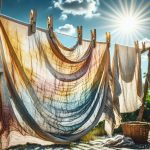When you spend a day at the beach, have you ever considered how your clothing impacts your skin’s protection from UV rays? Different fabrics offer varying levels of natural UV defense, and knowing which ones to choose can make a significant difference. But what exactly are the best options available, and how can you enhance their protective qualities? Let’s explore the world of fabrics and find out what truly keeps you safe under the sun.
Table of Contents
Key Takeaways
- Tightly woven cotton provides effective UV protection, blocking harmful rays while maintaining breathability.
- Linen offers decent UV defense and breathability, making it suitable for warm weather.
- Silk’s dense fibers naturally block UV rays, providing good sun protection.
- Hemp is durable and offers strong UV protection, ideal for outdoor clothing.
- Darker-colored fabrics enhance UV absorption, improving overall protection against harmful rays.
Overview of Natural UV Protection
When you think about sun protection, it’s easy to focus solely on sunscreen, but natural UV protection through fabrics is just as important.
The clothes you wear can greatly impact your skin’s exposure to harmful ultraviolet rays. Certain fabrics offer inherent UV-blocking properties, helping shield your skin without the need for additional products.
For instance, tightly woven materials like denim and synthetic blends often provide better protection than loose, lightweight textiles. Darker colors generally absorb more UV radiation, while lighter shades can reflect it.
Additionally, specific natural fibers, such as cotton, can also offer varying degrees of protection depending on their thickness and weave. Understanding these factors helps you make informed choices about your wardrobe for effective sun safety.
Factors Affecting UV Protection in Natural Fabrics
When choosing natural fabrics for UV protection, several factors come into play.
You need to contemplate the weave tightness, fabric weight, and even the color, as each can notably influence how well the material shields you from harmful rays.
Understanding these elements will help you make informed choices for effective sun protection.
Weave Tightness Impact
The tightness of a fabric’s weave plays an essential role in its ability to provide natural UV protection.
When you choose tightly woven fabrics, like denim or canvas, you’re more likely to block harmful UV rays compared to looser weaves. A denser weave means fewer gaps for UV radiation to penetrate, giving you better coverage.
Fabrics with a finer thread count usually offer enhanced protection as well, since the threads are packed more closely together.
So, if you’re looking for effective UV shielding, focus on those tightly woven materials.
Fabric Weight Significance
While the tightness of a fabric’s weave greatly impacts UV protection, fabric weight is another essential factor to evaluate. Heavier fabrics typically provide better UV resistance because they’re denser, blocking more harmful rays from reaching your skin.
When you’re choosing materials, consider options like canvas or denim, which are heavier and offer greater protection compared to lighter fabrics like cotton or linen. However, keep in mind that weight can also affect comfort; a heavy fabric mightn’t be ideal for hot weather.
Ultimately, you want to find a balance between weight and breathability while ensuring you’re protected from UV rays. So, when shopping, pay attention to the fabric weight, as it plays a vital role in your UV defense.
Color’s Role in Protection
Color plays an essential role in the UV protection offered by natural fabrics. Darker colors, like navy or black, absorb more UV rays than lighter shades, providing better protection. If you’re choosing clothing for sun exposure, consider opting for deeper hues.
While lighter colors may keep you cooler, they reflect UV rays rather than absorbing them, which can leave you more vulnerable. Additionally, certain pigments add extra UV-blocking capabilities.
If you’re serious about sun safety, look for specific clothing labeled with a UPF rating, which indicates the fabric’s effectiveness against UV radiation.
Comparison of Synthetic and Natural Fabrics for UV Protection
When choosing fabrics for UV protection, you’ll notice significant differences between synthetic and natural options.
Synthetic fabrics often boast superior durability and longevity, while natural fabrics provide a more breathable feel.
Understanding these performance aspects can help you make a better choice for your needs.
Fabric Performance Comparison
Synthetic and natural fabrics each offer unique advantages when it comes to UV protection, making it essential to understand their performance.
Synthetic fabrics, like polyester and nylon, often have a higher Ultraviolet Protection Factor (UPF) due to their tight weaves and chemical treatments. They resist moisture and dry quickly, which can enhance comfort during outdoor activities.
On the other hand, natural fabrics, such as cotton and linen, can provide decent UV protection, but often require thicker weaves for maximum effectiveness. While they’re breathable and comfortable, their performance under sunlight can be inconsistent.
Ultimately, choosing between synthetic and natural fabrics depends on your specific needs, such as comfort, breathability, and the level of UV protection you’re seeking.
Durability and Longevity
While both synthetic and natural fabrics offer UV protection, their durability and longevity differ markedly.
Synthetic fabrics, like polyester and nylon, tend to withstand wear and tear better than many natural options. They’re resistant to fading and damage from UV rays, making them ideal for outdoor use.
On the other hand, natural fabrics such as cotton or linen may not hold up as well over time, especially when exposed to harsh sunlight. They can weaken and fade faster, requiring more frequent replacements.
However, natural fabrics are often more breathable and comfortable.
Ultimately, if you’re looking for long-lasting UV protection, consider the balance between the durability of synthetic materials and the comfort of natural fabrics, depending on your specific needs.
Specific Natural Fibers That Provide UV Protection
Several natural fibers offer impressive UV protection, making them ideal choices for sun-safe clothing.
Cotton, particularly tightly woven varieties, can block out harmful rays effectively.
Tightly woven cotton effectively blocks harmful UV rays, making it a smart choice for sun-safe clothing.
Linen is another excellent option; its loose weave allows for breathability while still providing decent UV defense.
Silk is surprisingly good too, as its dense fibers have natural UV-blocking properties.
Hemp stands out for its durability and strong UV protection, making it perfect for outdoor wear.
Wool, though often overlooked, also provides a solid level of protection thanks to its natural structure.
By choosing these fibers, you’re not just prioritizing comfort but also safeguarding your skin from the sun’s damaging effects.
Consider incorporating these into your wardrobe for superior sun protection.
Enhancing UV Protection in Natural Fabrics
To enhance UV protection in natural fabrics, you can employ various techniques that boost their sun-blocking capabilities without sacrificing comfort.
Here are some effective methods:
- Choose darker colors: Darker shades absorb more UV rays, providing better protection than lighter hues.
- Opt for tighter weaves: Fabrics with closely woven fibers block UV rays more effectively compared to loosely woven options.
- Add UV-blocking agents: Some treatments can be applied to fabrics to enhance their UV resistance, ensuring longer-lasting protection.
- Layer your clothing: Wearing multiple layers can greatly increase UV protection, creating a barrier against harmful rays.
Understanding UPF Ratings of Different Fabrics
When it comes to protecting your skin from harmful UV rays, understanding UPF (Ultraviolet Protection Factor) ratings of various fabrics is crucial.
UPF ratings indicate how much UV radiation can penetrate the fabric. A UPF of 15 to 20 offers good protection, blocking about 93-95% of UV rays. Fabrics with a UPF of 30 or higher provide excellent protection, blocking about 97% of UV rays.
Keep in mind that darker colors and tightly woven fabrics usually offer better protection. Additionally, factors like wetness and stretch can reduce a fabric’s effectiveness.
Sustainable Choices for UV Protection in Fabrics
As you seek effective UV protection, consider the benefits of sustainable fabrics that not only shield your skin but also reduce environmental impact.
Opting for these materials can enhance your wardrobe while being eco-friendly. Here are some top choices:
Enhance your style with eco-friendly fabrics that protect your skin and the planet.
- Organic Cotton: Grown without harmful pesticides, it’s soft, breathable, and offers decent UV protection.
- Hemp: Naturally resistant to UV rays, hemp grows quickly and requires minimal water and chemicals.
- Tencel: Made from sustainably sourced wood pulp, it’s biodegradable and offers good UV blocking properties.
- Recycled Polyester: Repurposed plastic bottles help reduce waste, and this fabric can provide UV resistance while being lightweight.
Frequently Asked Questions
How Do UV Rays Affect Fabric Longevity?
You might think UV rays just tan your skin, but they actually weaken fabrics too. Over time, they cause fading and deterioration, reducing your clothes’ lifespan. So, protect your wardrobe from those sneaky sun rays!
Can UV Protection Diminish After Multiple Washes?
Yes, UV protection can diminish after multiple washes. As you clean fabrics, the protective chemicals may break down, reducing their effectiveness. To maintain UV defense, consider using gentle detergents and following care instructions carefully.
Are There Eco-Friendly Treatments for UV Protection?
You’d think finding eco-friendly UV treatments is like searching for a unicorn, but they exist! Plant-based options and mineral coatings can effectively shield you from harmful rays while being kind to the planet. Explore your choices!
What Role Does Fabric Color Play in Style and UV Protection?
Fabric color greatly influences both style and UV protection. Darker colors absorb more UV rays, while lighter shades reflect them. Choosing the right color not only enhances your look but also helps shield your skin effectively.
How Do Uv-Blocking Fabrics Perform in Humid Conditions?
UV-blocking fabrics in humid conditions perform like an umbrella in a storm, keeping you protected. They can feel heavier and less breathable, so choose lightweight options to stay comfortable while still enjoying sun protection.
- The History of Tie-Dye: From Ancient Art to 60s Counter-Culture - July 13, 2025
- How to Revamp Your Wardrobe With Simple Tie-Dye Techniques - July 13, 2025
- A Deep Dive Into the Chemistry of Tie-Dye - July 13, 2025







